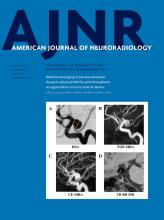Abstract
BACKGROUND AND PURPOSE: Assessment of the collateral status has been emphasized for appropriate treatment decisions in patients with acute ischemic stroke. The purpose of this study was to introduce a multiphase MRA collateral imaging method (collateral map) derived from time-resolved dynamic contrast-enhanced MRA and to verify the value of the multiphase MRA collateral map in acute ischemic stroke by comparing it with the multiphase collateral imaging method (MRP collateral map) derived from dynamic susceptibility contrast-enhanced MR perfusion.
MATERIALS AND METHODS: From a prospectively maintained registry of acute ischemic stroke, MR imaging data of patients with acute ischemic stroke caused by steno-occlusive lesions of the unilateral ICA and/or the M1 segment of the MCA were analyzed. We generated collateral maps using dynamic signals from dynamic contrast-enhanced MRA and DSC-MRP using a Matlab-based in-house program and graded the collateral scores of the multiphase MRA collateral map and the MRP collateral map independently. Interobserver reliabilities and intermethod agreement between both collateral maps for collateral grading were tested.
RESULTS: Seventy-one paired multiphase MRA and MRP collateral maps from 67 patients were analyzed. The interobserver reliabilities for collateral grading using multiphase MRA or MRP collateral maps were excellent (weighted κ = 0.964 and 0.956, respectively). The agreement between both collateral maps was also excellent (weighted κ = 0.884; 95% confidence interval, 0.819–0.949).
CONCLUSIONS: We demonstrated that the dynamic signals of dynamic contrast-enhanced MRA could be used to generate multiphase collateral images and showed the possibility of the multiphase MRA collateral map as a useful collateral imaging method in acute ischemic stroke.
ABBREVIATIONS:
- AIS
- acute ischemic stroke
- DCE-MRA
- dynamic contrast-enhanced MRA
- DSC-MRP
- dynamic susceptibility contrast-enhanced MR perfusion
- mMRA
- multiphase MRA
- MRP
- MR perfusion
- © 2019 by American Journal of Neuroradiology
Indicates open access to non-subscribers at www.ajnr.org












